M² Fitting Examples
Scott Prahl
Sept 2023
This notebook describes the fitting procedure and shows five examples of how M² fitting by laserbeamsize produces beam parameters that match those made by others.
[1]:
import numpy as np
import matplotlib.pyplot as plt
import laserbeamsize as lbs
Example 1
Nice example from RP Photonics, but what is the wavelength? If the XeCl excimer laser line at 308nm is chosen, then M² works out.

The vertical lines in the graph are the 1X and 2X the Rayleigh distance from the beam waist.
[2]:
# datapoints digitized by hand from the graph above
# https://www.rp-photonics.com/beam_quality.html
lambda1=308e-9
z1_all=np.array([-200,-180,-160,-140,-120,-100,-80,-60,-40,-20,0,20,40,60,80,99,120,140,160,180,200])*1e-3
d1_all=2*np.array([416,384,366,311,279,245,216,176,151,120,101,93,102,120,147,177,217,256,291,316,348])*1e-6
lbs.M2_radius_plot(z1_all, d1_all, lambda1, strict=True)
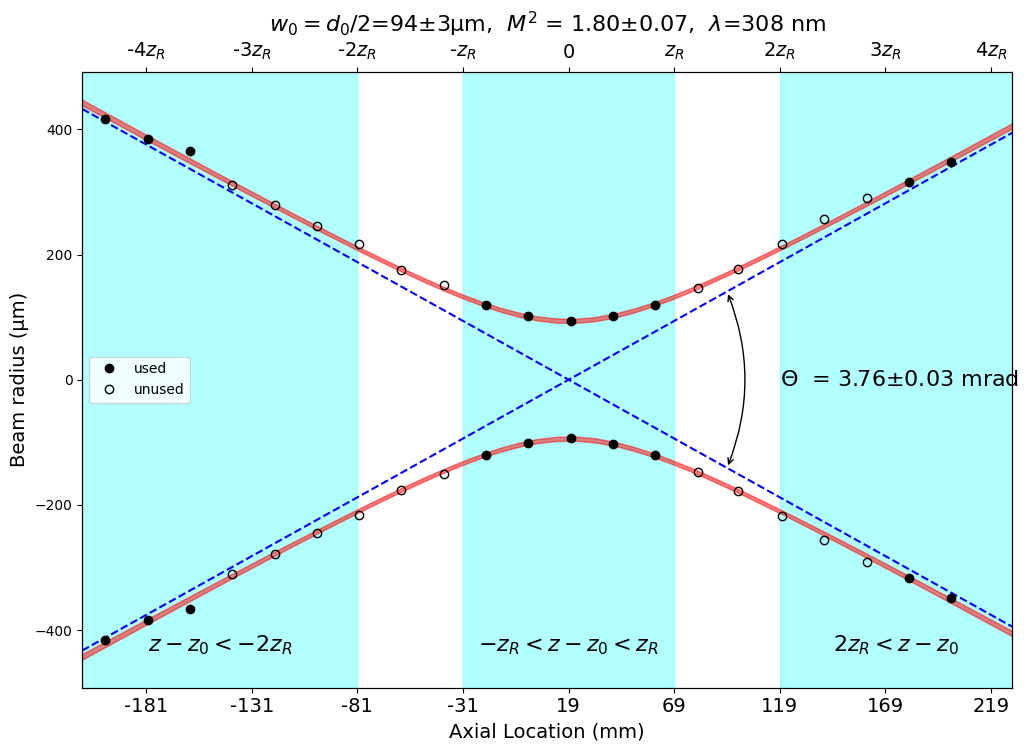
Example 2
Here is an example from a paper by Jiang in High Power Laser Science and Engineering. Despite a good fit, the M² values generated using laserbeamsize do not agree with the published values. This is troubling because the low M²
values are a major point of the paper. I finally decided that they just included the wrong graph (since all the labels were obviously added afterwards.)
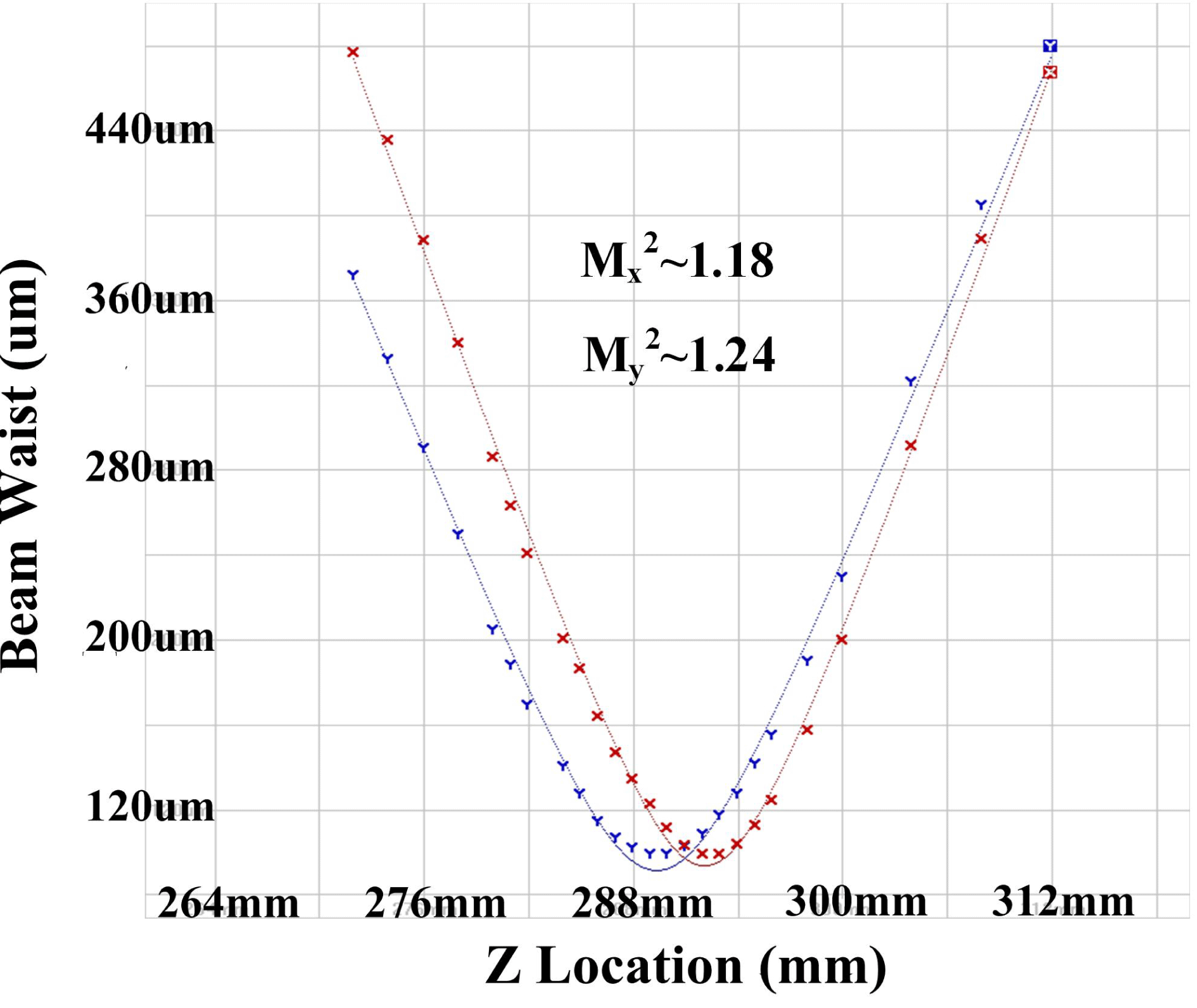
[3]:
# datapoints digitized by hand from the graph above
lambda2 = 1064.36e-9
z2 = np.array([272,274,276,278,280,281,282,284,285,286,287,288,289,290,291,292,293,294,295,296,298,300,304,308,312]) * 1e-3
dx2 = np.array([479,436,388,339,286,263,242,201,187,166,147,134,124,113,102,99,99,104,113,125,158,198,291,388,467]) * 1e-6
dy2 = np.array([371,332,290,250,203,189,171,140,128,115,107,103,99,100,102,107,118,127,141,157,190,231,321,405,481]) * 1e-6
lbs.M2_diameter_plot(z2, dx2, lambda2, dy=dy2, strict=True)
plt.show()
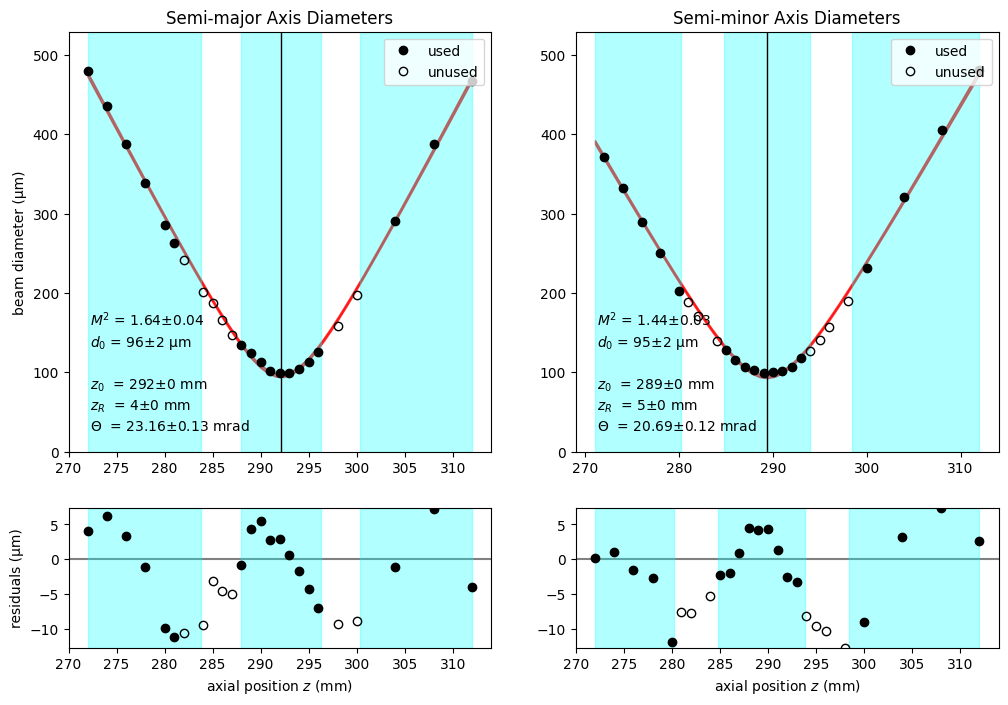
Example 3
A paper by Mirzaeian applies the M² formalism to characterize thermal lensing in a Yb\(^{+3}\)-doped KYW laser emitting from 1010-1070nm.
Only the data from the graph on the right side of Figure 4 is examined, but the results match exactly. This is also a nice example because the M² values agree.

[4]:
# datapoints digitized by hand from the graph above
lambda3=1040e-9
z3 = np.array([5.0,10.0,13.0,13.5,14.0,14.3,14.7,15.0,15.3,15.7,16.0,16.5,17.0,20.0,25.0]) * 1e-2
dy3 = 2*np.array([594,298,121,97,74,70,68,68,75,90,99,124,149,319,613]) * 1e-6
dx3 = 2*np.array([462,237,114,98,90,85,83,85,87,93,101,112,129,244,476]) * 1e-6
lbs.M2_diameter_plot(z3, dx3, lambda3, dy=dy3, strict=True)
plt.show()
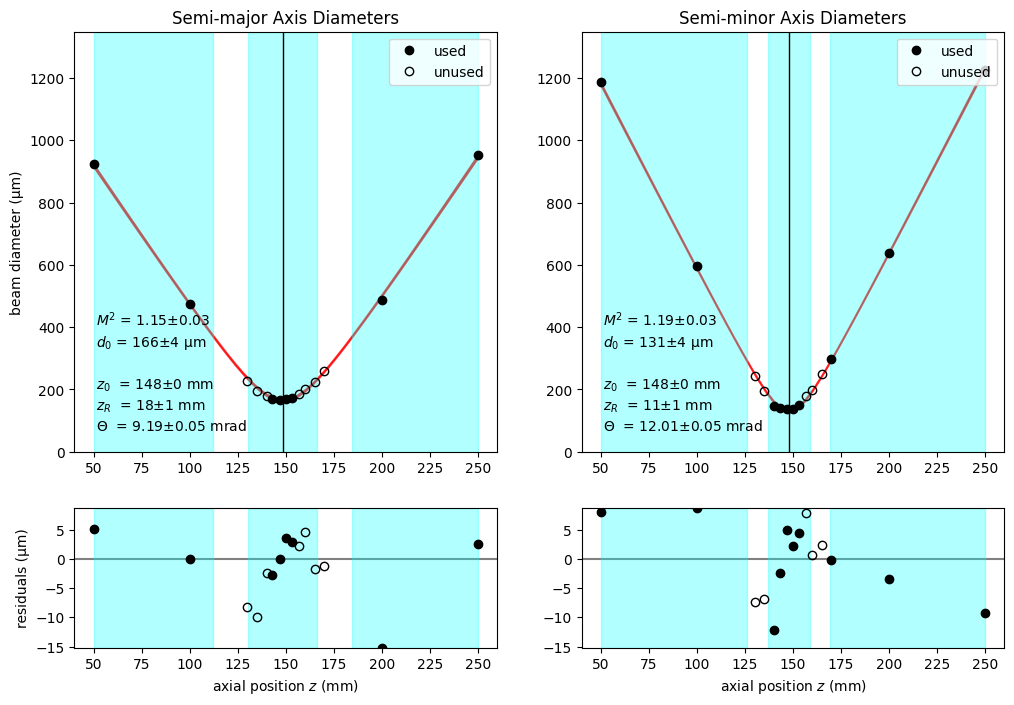
Example 4
Ophir sells beam scanners. They posted a screen shot of their software that contains the digitized beam diameters and the derived beam parameters. laserbeamsize fits the data and arrives at the same results (all except for the location \(z_0\), which I suspect has something to do with how they define 0mm in the laboratory).
This example also exposed the need to start the fitting process with approximately correct values. Once that was done, laserbeamsize.beam_fit() matched those from the NanoModeScan software.

[5]:
# datapoints copied by hand from the table above
lambda4=633e-9
f4 = 200e-3 # focal length of lens
d_scan_head = 100e-3
z4 = np.array([100,120,140,160,180,400,420,440,460,480]) * 1e-3 + d_scan_head
dx4 = np.array([297,266,254,259,273,845,909,973,1038,1102]) * 1e-6
dy4 = np.array([300,269,256,257,273,840,905,969,1031,1096]) * 1e-6
lbs.M2_diameter_plot(z4, dx4, lambda4, dy=dy4, strict=True)
plt.show()
params, errors, used = lbs.M2_fit(z4, dx4, lambda4)
o_paramsx, o_errorsx = lbs.artificial_to_original(params, errors, f4)
d0x, z0x, Thetax, M2x, zRx = o_paramsx
d0x_std, z0x_std, Thetax_std, M2x_std, zRx_std = o_errorsx
params, errors, used = lbs.M2_fit(z4, dy4, lambda4)
o_paramsy, o_errorsy = lbs.artificial_to_original(params, errors, f4)
d0y, z0y, Thetay, M2y, zRy = o_paramsy
d0y_std, z0y_std, Thetay_std, M2y_std, zRy_std = o_errorsy
print(' Ophir laserbeamsize')
print('M2x 1.01 %.2f ± %.2f ' % (M2x, M2x_std))
print('M2y 1.01 %.2f ± %.2f' % (M2y, M2y_std))
print()
print('d0x 539 %.0f ± %.0f µm' % (d0x*1e6, d0x_std*1e6))
print('d0y 537 %.0f ± %.0f µm' % (d0y*1e6, d0y_std*1e6))
print()
print('Thetax 1.51 %.2f ± %.0f mrad' % (Thetax*1e3, Thetax_std*1e3))
print('Thetay 1.52 %.2f ± %.0f mrad' % (Thetay*1e3, Thetay_std*1e3))
print()
print('z0x 930 %.0f ± %.0f mm' % (z0x*1e3, z0x_std*1e3))
print('z0y 935 %.0f ± %.0f mm' % (z0y*1e3, z0y_std*1e3))
print()
print('zRx 357 %.0f ± %.0f mm' % (zRx*1e3, zRx_std*1e3))
print('zRy 353 %.0f ± %.0f mm' % (zRy*1e3, zRy_std*1e3))
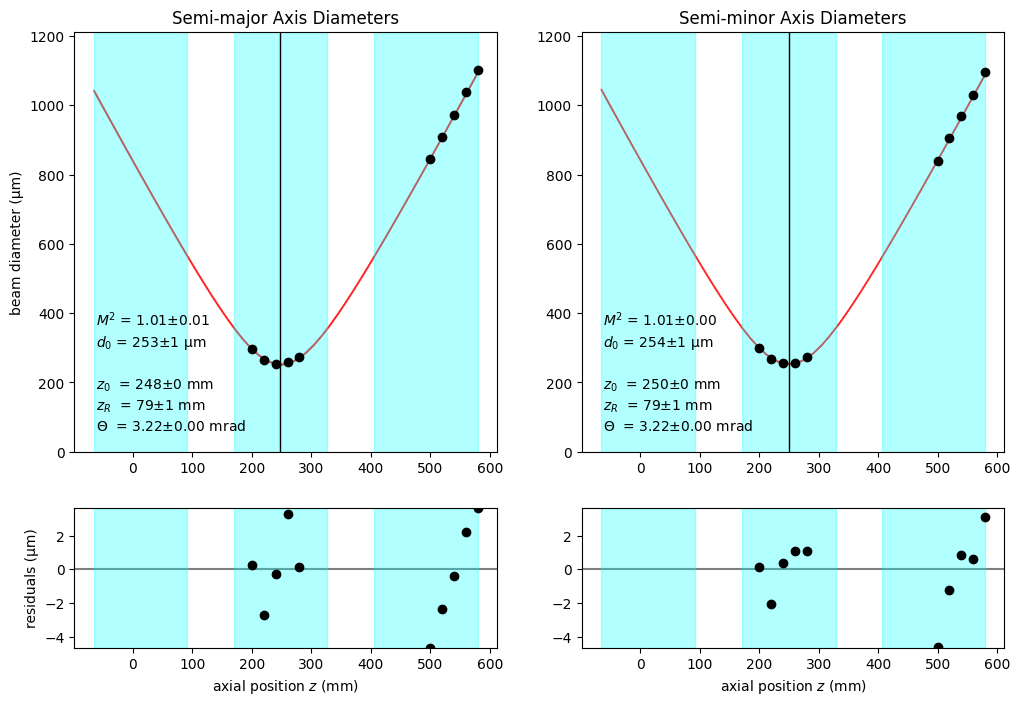
Ophir laserbeamsize
M2x 1.01 1.01 ± 0.01
M2y 1.01 1.01 ± 0.01
d0x 539 549 ± 3 µm
d0y 537 545 ± 3 µm
Thetax 1.51 1.48 ± 0 mrad
Thetay 1.52 1.50 ± 0 mrad
z0x 930 427 ± 6 mm
z0y 935 429 ± 4 mm
zRx 357 370 ± 5 mm
zRy 353 363 ± 4 mm
Example 5
Another example that I think came from Ophir Optics. The focused beam waist and divergence match within error. To match the M² result, a wavelength of 620nm was needed.
The focal length of the focusing lens was assumed to be 300mm. Reasonably close agreement was achieved although extrapolated values for the laser beam waist are reversed
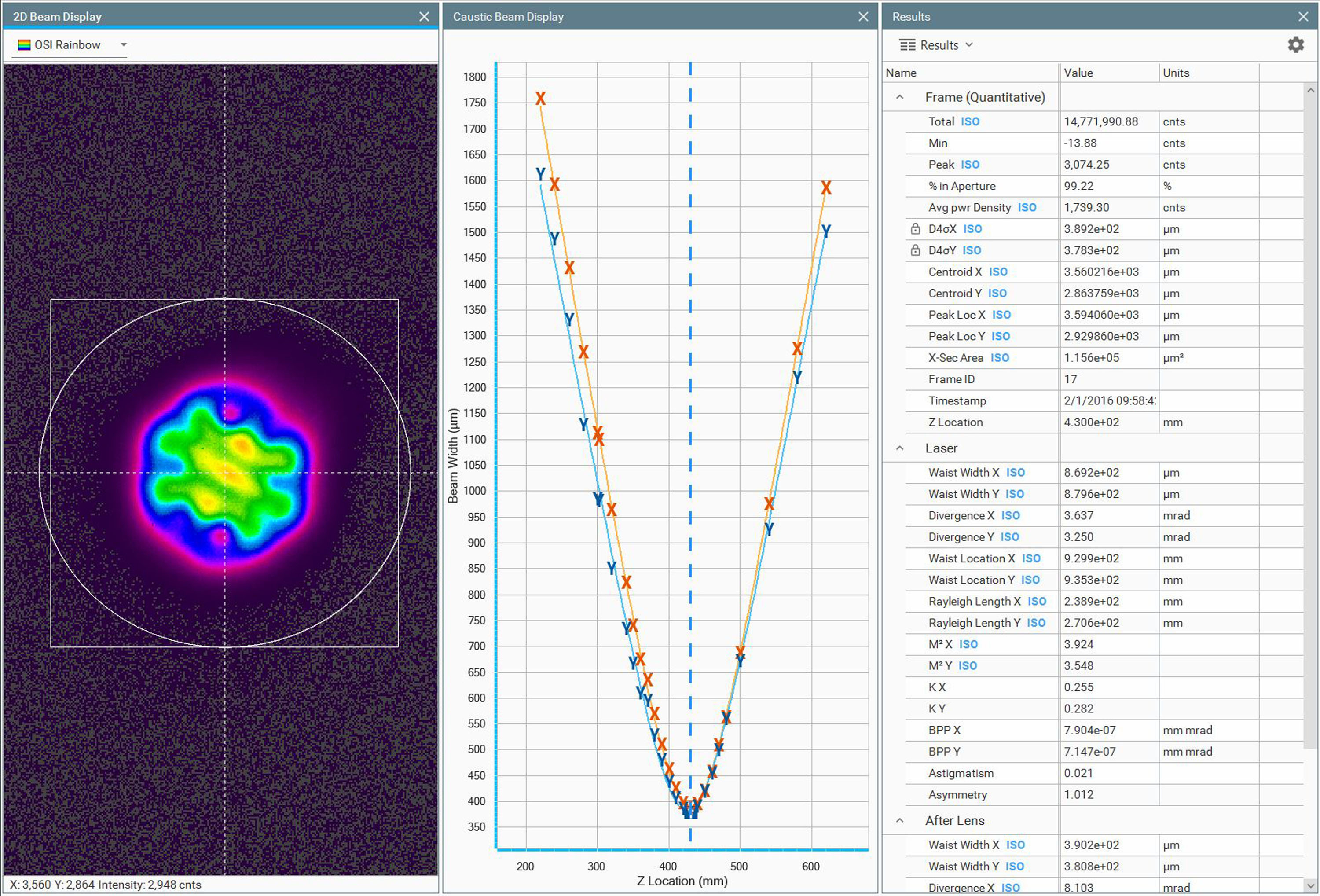
[6]:
# these values were digitized by hand from the above graph
z5=np.array([220,240,260,280,300,320,340,350,360,370,380,390,400,410,420,430,440,450,460,470,480,500,540,580,620])*1e-3
dx5=np.array([1758,1591,1431,1265,1111,963,823,740,687,633,568,510,469,426,398,394,394,419,455,512,560,689,972,1274,1584])*1e-6
dy5=np.array([1614,1487,1330,1133,996,857,740,673,609,595,526,478,440,406,385,382,383,419,449,499,550,668,917,1207,1503])*1e-6
lambda5=620e-9 # wavelength of laser
f5 = 300e-3 # focal length of lens
paramsx, errorsx, used = lbs.M2_fit(z5, dx5, lambda5, strict=True)
paramsy, errorsy, used = lbs.M2_fit(z5, dy5, lambda5, strict=True)
d0x, z0x, Thetax, M2x, zRx = paramsx
d0y, z0y, Thetay, M2y, zRy = paramsy
d0x_std, z0x_std, Thetax_std, M2x_std, zRx_std = errorsx
d0y_std, z0y_std, Thetay_std, M2y_std, zRy_std = errorsy
print('Artificial focus')
print(' Expected lbs')
print('M2x 3.92 %.2f ± %.2f ' % (M2x, M2x_std))
print('M2y 3.55 %.2f ± %.2f' % (M2y, M2y_std))
print('d0x 390 %.0f ± %.0f µm' % (d0x*1e6, d0x_std*1e6))
print('d0y 381 %.0f ± %.0f µm' % (d0y*1e6, d0y_std*1e6))
print('Thetax 8.10 %.2f ± %.0f mrad' % (Thetax*1e3, Thetax_std*1e3))
o_paramsx, o_errorsx = lbs.artificial_to_original(paramsx, errorsx, f5)
o_paramsy, o_errorsy = lbs.artificial_to_original(paramsy, errorsy, f5)
d0x, z0x, Thetax, M2x, zRx = o_paramsx
d0y, z0y, Thetay, M2y, zRy = o_paramsy
d0x_std, z0x_std, Thetax_std, M2x_std, zRx_std = o_errorsx
d0y_std, z0y_std, Thetay_std, M2y_std, zRy_std = o_errorsy
print()
print('Original Beam')
print(' Expected lbs')
print('M2x 3.92 %.2f ± %.2f ' % (M2x, M2x_std))
print('M2y 3.55 %.2f ± %.2f' % (M2y, M2y_std))
print('d0x 869 %.0f ± %.0f µm' % (d0x*1e6, d0x_std*1e6))
print('d0y 880 %.0f ± %.0f µm' % (d0y*1e6, d0y_std*1e6))
print('Thetax 3.64 %.2f ± %.0f mrad' % (Thetax*1e3, Thetax_std*1e3))
print('Thetay 3.25 %.2f ± %.0f mrad' % (Thetay*1e3, Thetay_std*1e3))
print('z0x 930 %.0f ± %.0f mm' % (z0x*1e3, z0x_std*1e3))
print('z0y 935 %.0f ± %.0f mm' % (z0y*1e3, z0y_std*1e3))
print('zRx 239 %.0f ± %.0f mm' % (zRx*1e3, zRx_std*1e3))
print('zRy 271 %.0f ± %.0f mm' % (zRy*1e3, zRy_std*1e3))
Artificial focus
Expected lbs
M2x 3.92 4.00 ± 0.03
M2y 3.55 3.60 ± 0.07
d0x 390 391 ± 3 µm
d0y 381 378 ± 7 µm
Thetax 8.10 8.09 ± 0 mrad
Original Beam
Expected lbs
M2x 3.92 4.00 ± 0.03
M2y 3.55 3.60 ± 0.07
d0x 869 845 ± 6 µm
d0y 880 832 ± 15 µm
Thetax 3.64 3.74 ± 0 mrad
Thetay 3.25 3.42 ± 0 mrad
z0x 930 908 ± 0 mm
z0y 935 913 ± 0 mm
zRx 239 226 ± 3 mm
zRy 271 243 ± 10 mm
[7]:
lbs.M2_radius_plot(z5, dx5, lambda5, strict=True)
plt.show()
lbs.M2_radius_plot(z5, dy5, lambda5, strict=True)
plt.show()
print(lbs.M2_report(z5,dx5,lambda5,dy=dy5,f=f5))
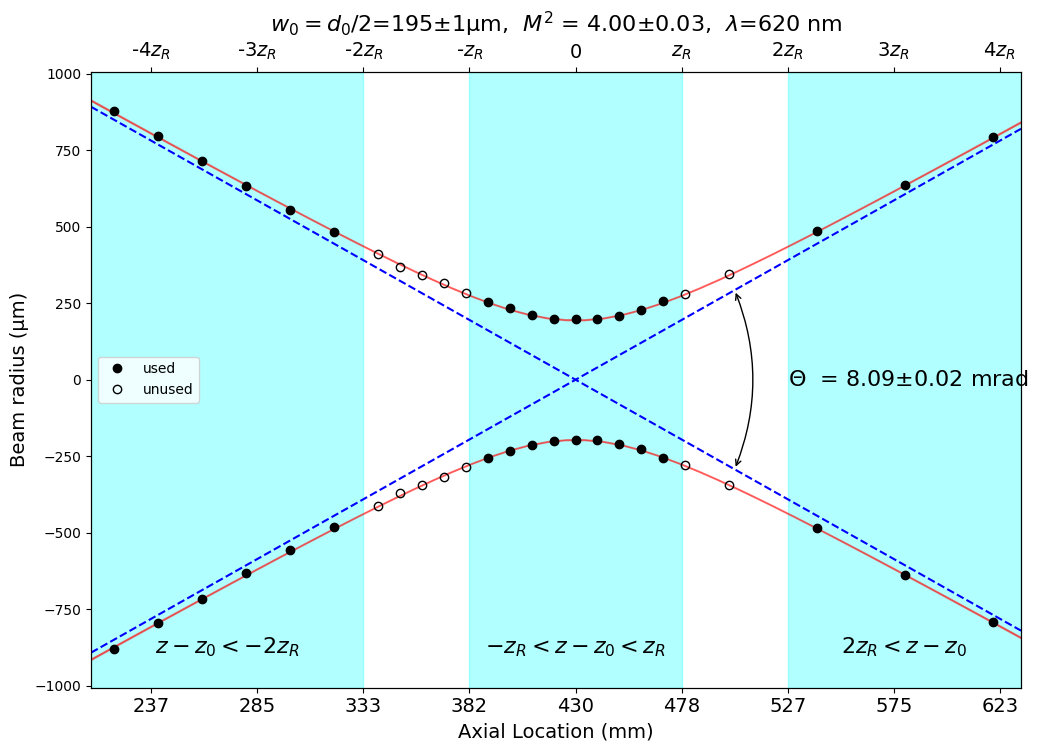
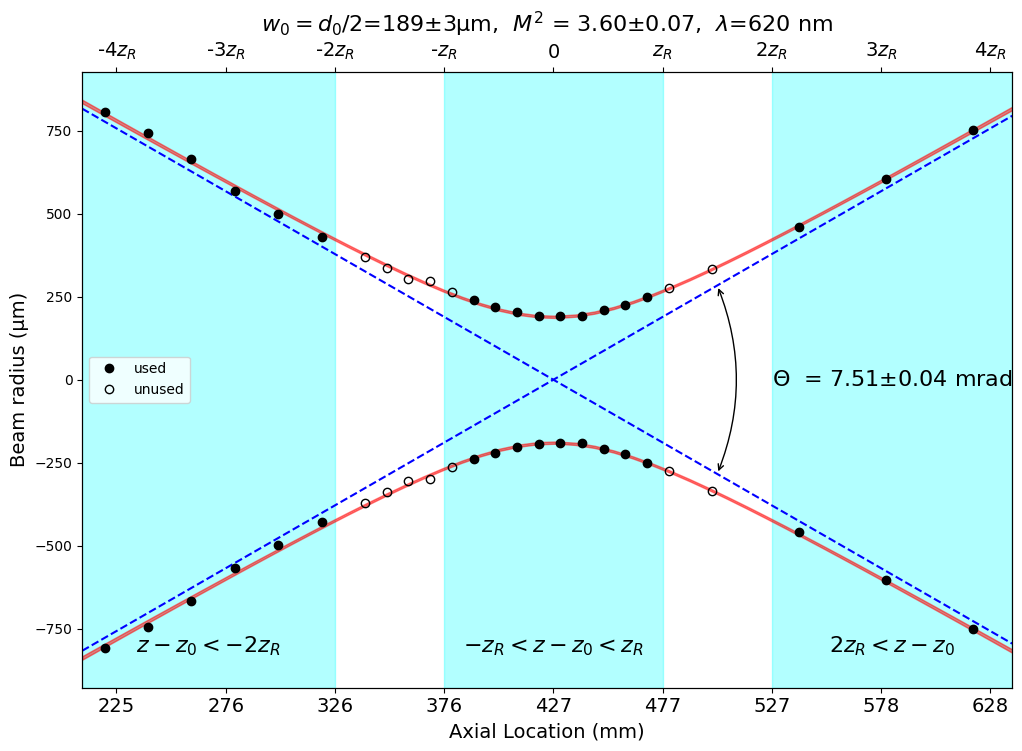
Beam propagation parameters derived from hyperbolic fit
Beam Propagation Ratio of the focused beam
M2 = 3.79 ± 0.07
M2x = 4.00 ± 0.03
M2y = 3.60 ± 0.06
Beam waist diameter of the focused beam
d0 = 384 ± 6 µm
d0x = 391 ± 2 µm
d0y = 378 ± 6 µm
Beam waist location of the focused beam
z0 = 428 ± 1 mm
z0x = 430 ± 0 mm
z0y = 427 ± 1 mm
Rayleigh Length of the focused beam
zR = 49 ± 2 mm
zRx = 48 ± 1 mm
zRy = 50 ± 2 mm
Divergence Angle of the focused beam
theta = 7.80 ± 0.05 milliradians
theta_x = 8.09 ± 0.02 milliradians
theta_y = 7.51 ± 0.04 milliradians
Beam parameter product of the focused beam
BPP = 0.75 ± 0.01 mm * mrad
BPP_x = 0.79 ± 0.01 mm * mrad
BPP_y = 0.71 ± 0.01 mm * mrad
[ ]: